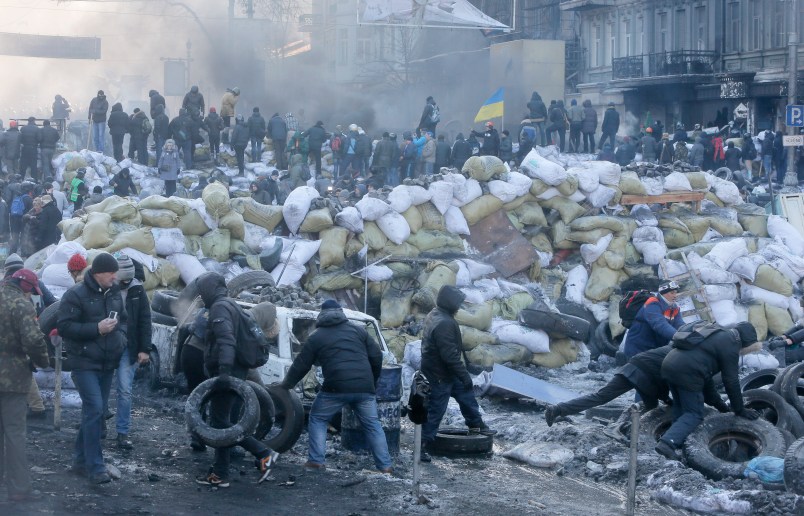KIEV, Ukraine (AP) — I heard a strange clanking sound this morning in my hotel room overlooking the Ukrainian capital’s main square. I carefully opened the balcony door and looked down. A bullet from a sniper rifle was on the floor of the balcony.
Apparently it had ricocheted off the rail.
Soon after, several protesters from Independence Square, known as the Maidan, knocked on my door. They wanted to check to see if any snipers were hiding in my room. The hotel director accompanied them, eager to prove that such things were impossible in his establishment.
Thursday was the bloodiest day in Ukraine’s post-Soviet history: At least 70 protesters were killed and hundreds were wounded by snipers on Kiev’s Independence Square and its nearby streets, according to medical workers treating the victims. Three police were also killed Thursday and 28 suffered wounds, according to the Interior Ministry.
HORRIFIC SURREAL IMAGES FROM KIEV
___
EDITOR’S NOTE — Yuras Karmanau has covered Ukraine, Belarus, Russia and other ex-Soviet nations for The Associated Press since 2000. He was among the first journalists to witness the carnage in Kiev on Thursday and describes the horrific scene.
___
Three months of protests against President Viktor Yanukovych had turned into a bloody carnage on the Maidan, as the square is known.
When I walked out into the Maidan, clad in a helmet and a flak jacket, I saw bodies lying on the pavement. Ten in one place, another six a short walk away, five more farther away. The demonstrators were killed with precise shots to their heads or necks, the hallmarks of snipers.
People were gathering around the dead, many of them weeping. Some covered the bodies with Ukrainian flags, others brought Orthodox icons. A priest conducted a remembrance service.
I felt a bit sick. Many of the victims were only in their 30s and 40s, full of energy just a few hours ago.
I kept asking myself: Why are they killing them? The protesters had no firearms that I could see, and snipers could have instead incapacitated them by shooting their feet or arms.
If the government had hoped that the killings would intimidate protesters and force them to leave the Maidan, it was clearly a miscalculation. The carnage only fueled anger and strengthened the demonstrators’ determination.
“The price of freedom is too high, but Ukrainians are paying it,” said Viktor Danilyuk, a 30-year-old protester. “We have no choice, the government isn’t hearing us.”
The Mikhailovsky Cathedral, a short walk up the hill from the Maidan, was turned into an improvised hospital complete with a surgery room to treat the victims.
“People who wanted to live in a free Ukraine in Europe got bullets instead,” said Petro Shumilin, a 33-year-old demonstrator who was wounded in the arm while carrying away a friend’s body.
His eyes were full of tears, both from the loss of his friend and from the pain of getting surgery for his wound.
“This is the result of Yanukovych’s rule,” Shumilin said. “He’s guilty of starting a civil war.”
The sniper fire that rang out on the streets of this city of nearly 3 million was something Kiev hasn’t heard since the World War II battles between the Soviet Red Army and Nazi forces.
Most of the wounded stayed away from Kiev’s hospitals, fearing they would be quickly taken into police custody from there — something that has happened to many others wounded in the clashes.
The daily demonstrations, which were sparked by anger over Yanukovych’s abrupt refusal in November to sign a pact with the European Union in favor of choosing closer ties with Russia, were peaceful at first. Violent clashes with police erupted in January, when at least four people died and hundreds were wounded in street battles that raged for days.
Yanukovych made some concessions and tensions abated for a few weeks, but they flared up again this week after Yanukovych loyalists in parliament refused to trim powers of the presidency as protesters had demanded. As they had in January, protesters assaulted police lines with stones and firebombs, but this time the police response was ferocious.
Earlier during the protests, life in Kiev went on as usual. Streets were full of people doing their daily errands. Stores, restaurants and cafes along the downtown avenue near the Maidan stayed open. The protest camp even became a daily attraction for many residents.
That all changed sharply this week, as clashes between protesters and police turned into urban warfare. The sound of police stun grenades echoed across the Maidan and heavy black smoke from burning tires, which protesters set to block the way to police, filled Kiev’s skies.
The subway shut down, schools and most offices in central Kiev were closed and streets became empty. People across the city rushed to get cash and buy staples. Most downtown restaurants and cafes were closed, so finding a place to eat became a real challenge.
But many ordinary people still came to the Maidan, to the front lines with police, bringing food, water and clothes to its exhausted defenders.
“Ukraine’s fate is being decided here — whether we will become part of Europe or slide back,” said Inga Leshchenko, a 67-year-old school teacher who brought homemade food to the protesters.
“Every Ukrainian should help the Maidan,” she said. “I can help by making sandwiches and homemade pies.”






